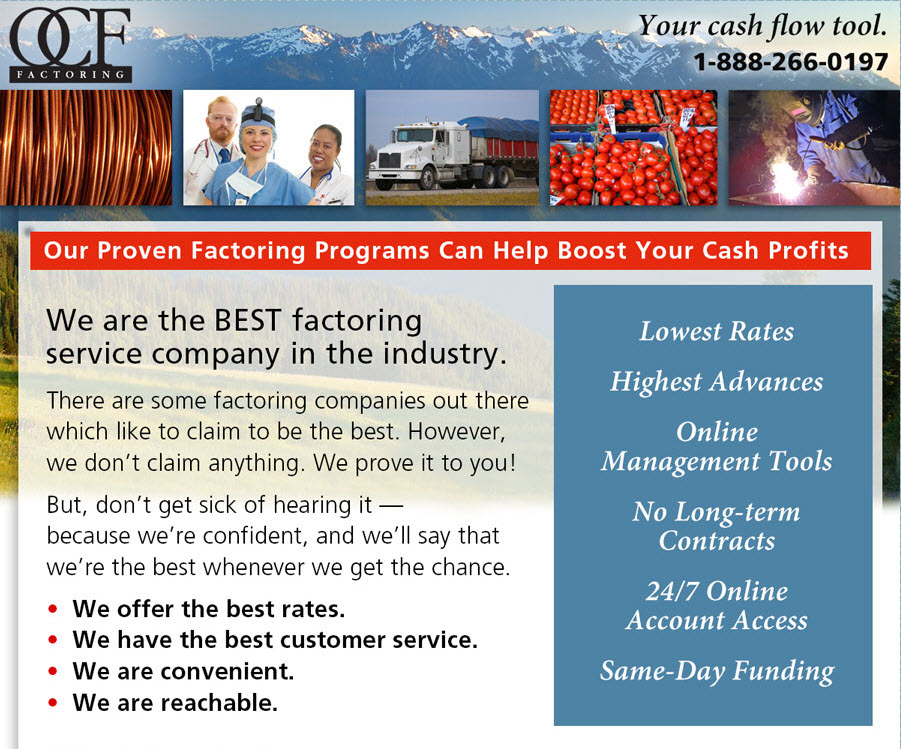Is Invoice Factoring For You?
The
key to knowing if factoring is
for you is to not to look only at the
bottom-line factoring fee,
but also to consider how your company
may increase it's profits through factoring.
Here is additional information on factoring
to help you with your decision.
How are invoice factoring fees
and advance rates determined?
It is based on several factors:
The creditworthiness of your clients
Your monthly billing volume
Average invoice size
Average days to payment
Fees can range from 2-5 % of
the invoice's face value.
For example if the invoice's value
is $1,000; a fee of 3% equals $30.
What is an advance?
The amount of money
you
receive immediately
when we buy your invoice.
The balance is returned to you when
your
customer pays the invoice.
Advances range from 60-95%
of the invoice's face value.
For example if the invoice's value is
$1,000 an advance rate of 80% equals $800.
The balance of $200 less the
factoring fee is returned to you when your
customer pays the invoice.
Comparing Bank Lending Rates to Factoring?
When compared to bank lending rates, factoring
initially
appears to be very expensive.
Here are five typical questions/concerns
that are raised by potential factoring clients
- Wow! 3 points per month! That's 36 percent year! (Rates range from 1.5- 3 points)
It is tempting to annualize the numbers, but that is an "apples and oranges" comparison.Banks loan money at an annualized interest rate, 12 percent per year for example. We purchase your receivables at a discount. The products are different and there are other inconsistencies
to this inappropriate comparison
The bank provides the money only one time, the day that you receive the loan; we provide money continuously. As an example, consider a bank loan for $100,000 at 12 percent. You receive the $100,000 just one time and then pay $1,000 interest per month interest and you still owe the $100,000. Or the bank could provide you with a line of credit that you use only when you need the money but the bank is charging you for that privilege and if you need to increase your line you
need to go through the qualifying process all over again.
When you factor $100,000 each month for a year you have the use of $1.2 million (12 x $100,000) over the year. Unlike a bank loan where you have just $100,000 one time. Assuming a 3 point discount, the fees over the year will be 12 x $3,000 or $36,000, which is still 3 percent of $1.2 million. And at the end of the year you have no debt!
- I'm only making 3% profit, how can I pay you 3 points?
A company making only 3% net profit can do more business volume as a result of factoring, and the larger volume will result in a higher profit margin because fixed costs do not increase with volume. The added business at a higher marginal profit leads to an increased overall profit margin. As the volume increases, the cost
of production decreases, so that profits increase. Fixed costs i.e., rent, electric, insurance, etc., increase very little or not at all with volume. An increase in business will not affect rent. Electric bills may rise slightly. Workers compensation insurance may rise slightly. These costs do not increase as do direct production costs.
Let's graphically do the math assuming you can double your sales
Without Factoring
| Monthly Gross Sales |
$50,000 |
|
| Cost of Goods Sold |
$30,000 |
60% of Gross Sales |
| Monthly Gross Profit |
$20,000 |
40% of Gross Sales |
| Fixed Expenses |
$10,000 |
|
| Variable Expenses |
$8,500 |
17% of Gross sales |
| Factoring Fee |
N/A |
|
| Total Expenses |
$18,500 |
37% of Gross Sales |
| Monthly Net Profit |
$1,500 |
3% of Gross Sales |
With Factoring
| Monthly Gross Sales |
$100,000 |
|
| Cost of Goods Sold |
$60,000 |
60% of Gross Sales |
| Monthly Gross Profit |
$40,000 |
40% of Gross Sales |
| Fixed Expenses |
$10,000 |
|
| Variable Expenses |
$17,000 |
17% of Gross Sales |
| Factoring Fee |
$3,000 |
3% Fee |
| Total Expenses |
$30,000 |
30% of Gross Sales |
| Monthly Net Profit |
$10,000 |
10% of Gross Sales |
- But I only get 80% of my money upfront!
(Advances typically range from 80%-97%)
Let's assume an advance rate of 80%. Let's also assume that you begin factoring in January. You have factored $100,000, we pay you $80,000 of that money
upfront, with the remaining money making up the fee (3%) of $3,000 and the reserve (17%) of $17,000.
Now in February, you once again factor $100,000 and receive $80,000. However. you also receive your January reserve of $17,000(assuming your customer pay in 30 days). So for February, you actually receive 97% of your money, instead of 80%.
In the second month and going forward you are basically receiving 97% of your cash flow.
- But what if my customers take longer than 30 days to pay?
You have several options, Assume your client takes 60 days to pay you bill your client in the normal fashion and simply allow 30 days to go by prior to factoring that invoice. That way you pay the 30 day fee.
Another way is to factor your faster customers first for the cash you need.

